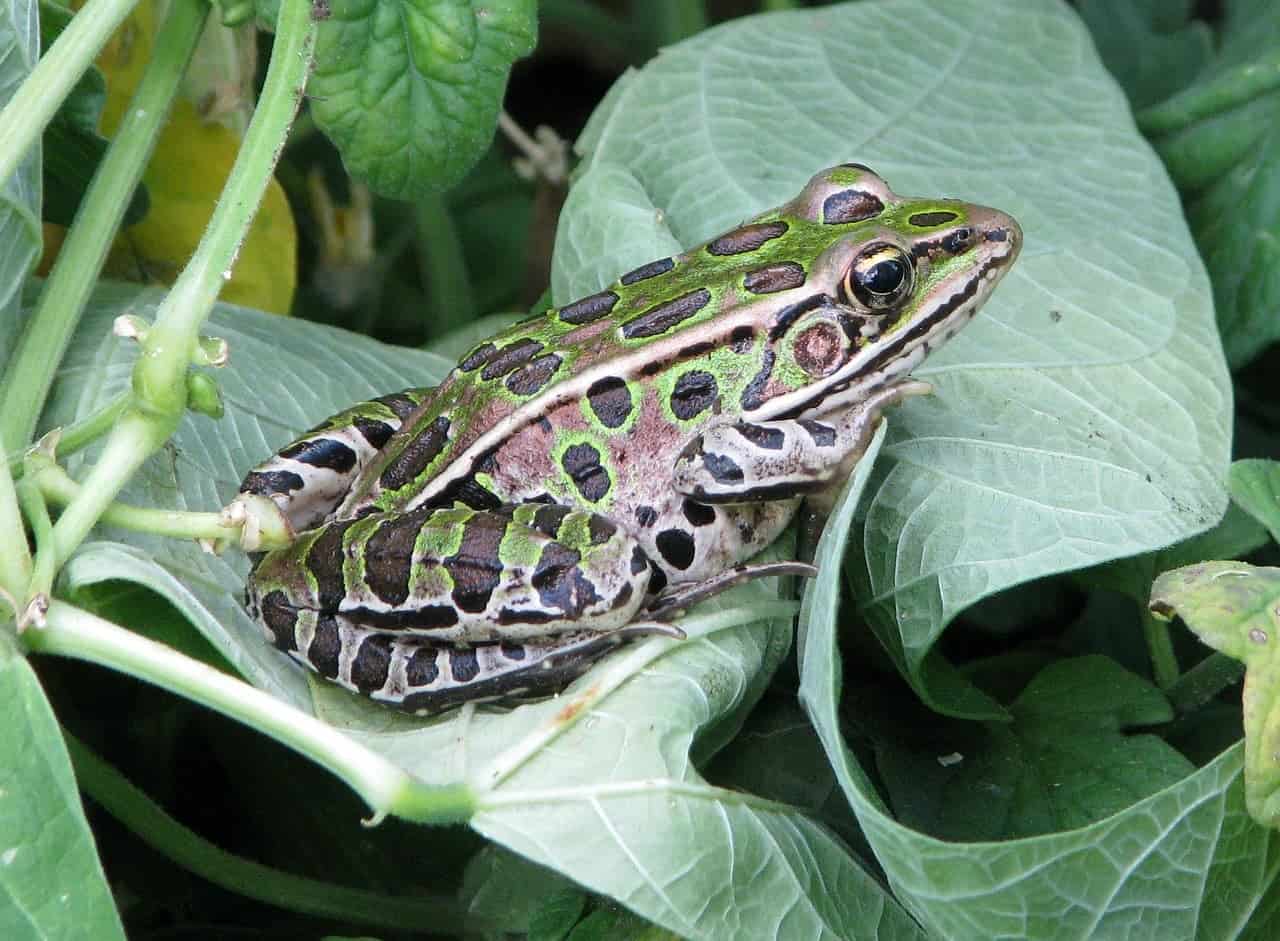Kentucky is home to many different frogs. Many are entirely harmless. However, there is one species of poisonous frog in this state: the Pickerel Frog.
Of course, these frogs are poisonous, not venomous. Therefore, you would have to eat it to be affected. Most people don’t go around eating random frogs, so humans typically don’t have anything to worry about.
There are about 23 different frogs and toads in Kentucky classified into five different groups. You can often get an idea of what species a particular frog is by knowing these groups. They are pretty distinctive from each other.
Here, we’ll take a look at some of the more common frog species.

The 19 Frogs Found in Kentucky
The 1 Poisonous Frog in Kentucky
1. Pickerel Frog
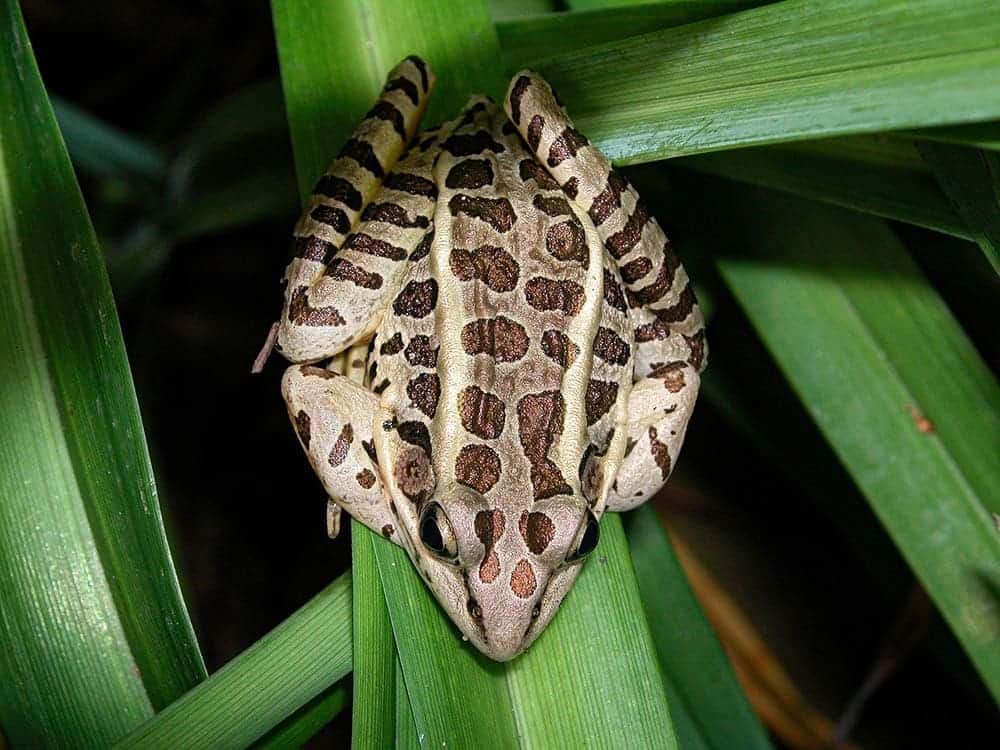
| Species: | Lithobates palustris |
| Longevity: | 5–8 years |
| Good to own as a pet?: | No |
| Legal to own?: | Yes |
| Adult size: | 1¾ to 4 inches |
| Diet: | Insects, spiders, invertebrates |
This is the only poisonous frog in Kentucky. It is recommended that you don’t handle it, as you may accidentally ingest some of the poison. For the most part, they are utterly harmless to people—you just don’t want your dog trying to eat it.
They are always a grey or tan color—never green—and have two rows of dark spots on their back. They often prefer to live near ponds with dense vegetation.
The 11 Little Frogs in Kentucky
2. Eastern Gray Tree Frog

| Species: | Hyla versicolor |
| Longevity: | 7 years |
| Good to own as a pet?: | Yes |
| Legal to own?: | Yes |
| Adult size: | 1¼ to 2 inches |
| Diet: | Insects and larvae |
Despite their name, this species ranges from brown to grey to green. They can vary quite a bit in coloration. Usually, they’re found up in the trees sleeping or singing. Their sticky pads enable them to climb up just about anything easily.
They are not found throughout Kentucky, just in a few counties.
3. Spring Peeper
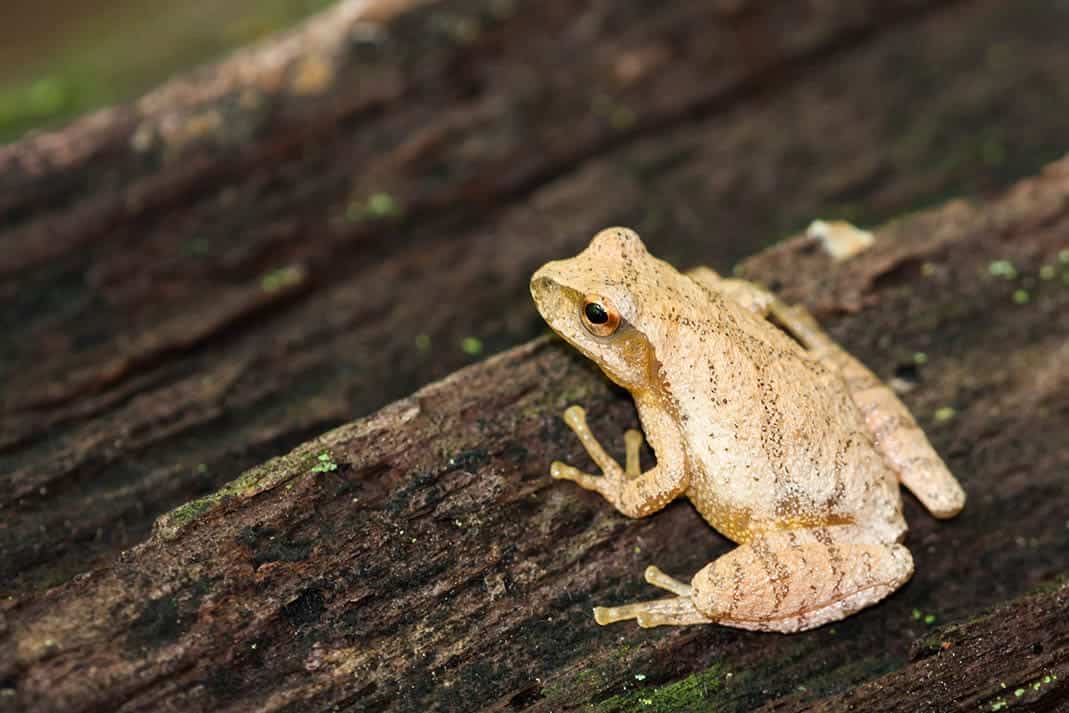
| Species: | Pseudacris crucifer |
| Longevity: | 3–4 years |
| Good to own as a pet?: | Yes |
| Legal to own?: | Yes |
| Adult size: | 1–1 ½ inches |
| Diet: | Insects |
This is one of the smallest frogs around, only reaching about 1 inch. They are common throughout Kentucky and spend most of their time on the ground hiding. They are commonly found in leaf litter of all sorts.
While it’s a frog, it spends much of its time on land. It only enters the water to breed or lay eggs.
4. Mountain Chorus Frog
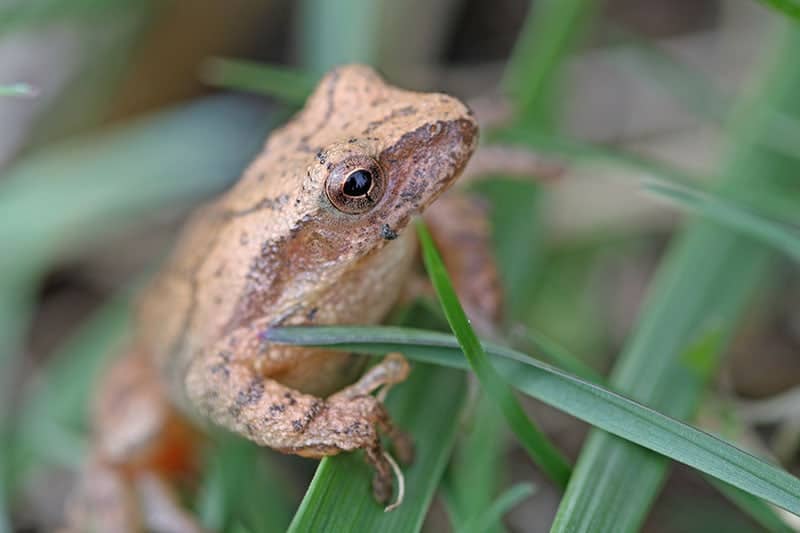
| Species: | Pseudacris brachyphona |
| Longevity: | 5 years |
| Good to own as a pet?: | Yes |
| Legal to own?: | Yes |
| Adult size: | 1 inch |
| Diet: | Insects |
The Mountain Chorus Frog has a range that covers eastern and southern Kentucky. It’s not usually found in water, preferring woodlands instead.
It usually ranges from tan to light brown, with darker brown markings found across the body. This is a relatively small species.
5. Eastern Narrow Mouth Toad
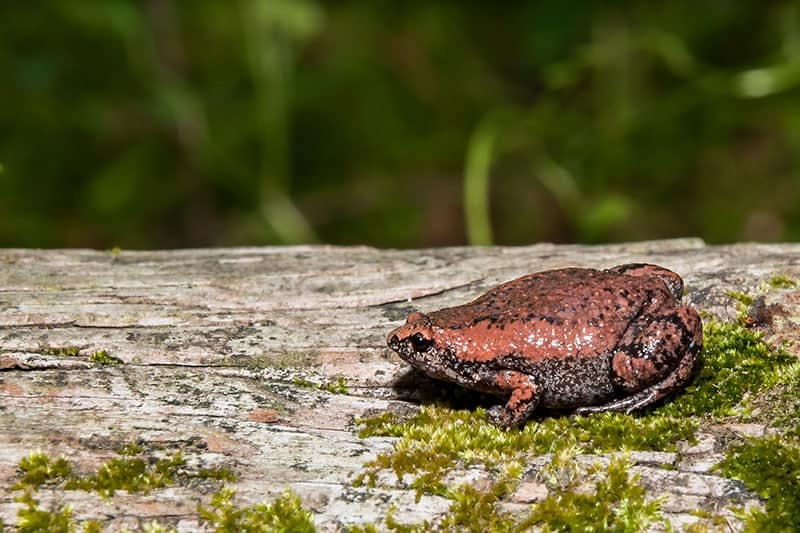
| Species: | Gastrophryne carolinensis |
| Longevity: | 6 years |
| Good to own as a pet?: | Yes |
| Legal to own?: | Yes |
| Adult size: | 1 inch |
| Diet: | Insects, especially ants |
While this amphibian has the word “toad” in its name, it isn’t a toad at all; it’s a frog. It’s either grey or brown with a characteristic fold on the back of its head. It’s usually found on rocky slopes and canyons. These frogs prefer to hide under rocks and similar debris.
They can be found in some areas of southern Kentucky.
6. Wood Frog
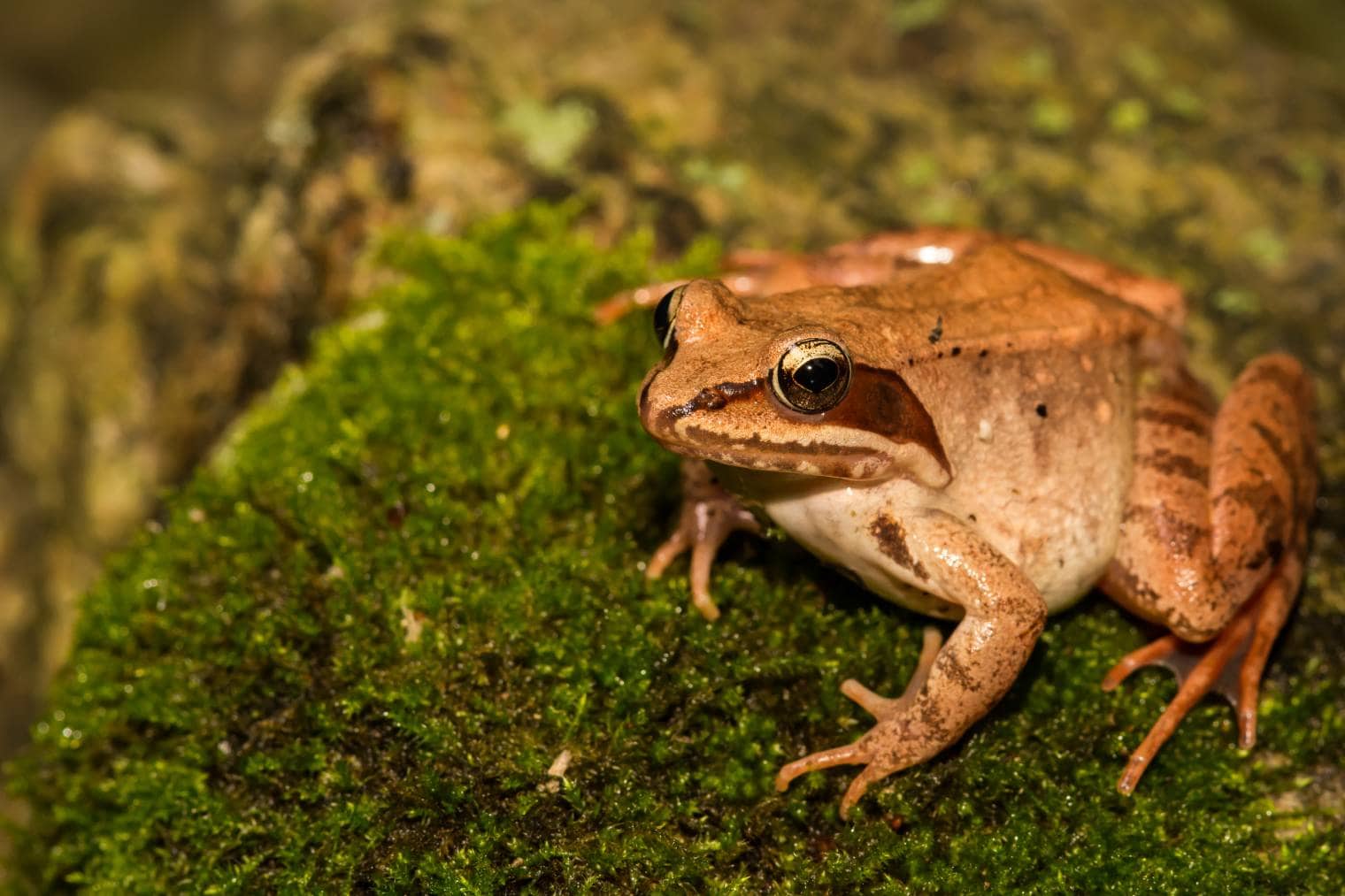
| Species: | Lithobates sylvaticus |
| Longevity: | 3 years max |
| Good to own as a pet?: | Yes |
| Legal to own?: | Yes |
| Adult size: | 1 ½ to 3 ¼ inches |
| Diet: | Insects |
The Wood Frog ranges from brown to tan to rusty. It often has a dark coloration around its eyes, commonly referred to as a robber’s mask. It’s found throughout much of Kentucky, except for some northern and western counties.
This species is exceptionally tolerant to colder temperatures. It can create a sugar solution that works like antifreeze, and it can tolerate freezing in up to 65% of the body.
7. Northern Leopard Frog
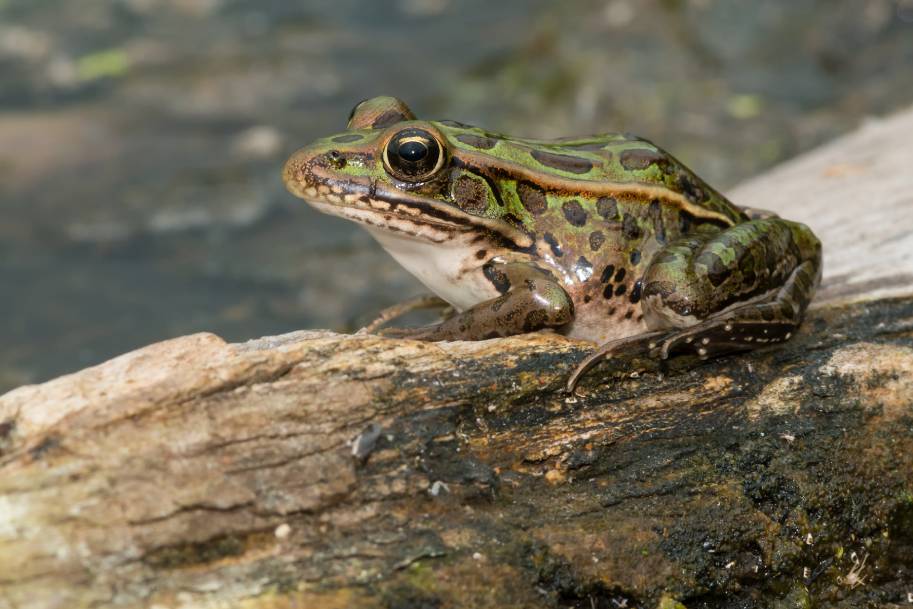
| Species: | Lithobates pipiens |
| Longevity: | 1–2 years |
| Good to own as a pet?: | Yes |
| Legal to own?: | Yes |
| Adult size: | 2–4½ inches |
| Diet: | Anything that fits in their mouth |
This species is characterized by its haphazardly spaced rows of oval-shaped dots on its back. Sometimes, these rows don’t look much like rows at all.
These frogs need access to three different habitats, including a permanent body of water for overwintering. This makes their range somewhat small, since their needs are so particular. As opportunistic feeders, they will eat just about anything, including birds and garter snakes. If it fits in their mouths, they will eat it.
8. Cope’s Gray Tree Frog

| Species: | Hyla chrysoscelis |
| Longevity: | 7–9 years old |
| Good to own as a pet?: | Yes |
| Legal to own?: | Yes |
| Adult size: | 1¼–2 inches |
| Diet: | Insects |
This species is somewhat smaller than the Gray Tree Frog. These two species can be difficult to distinguish from each other, especially since they are both mottled. Usually, the Cope’s Gray Tree Frog has a lime-green coloration, while the Gray Tree Frog varies more in coloration.
9. Blanchard’s Cricket Frog
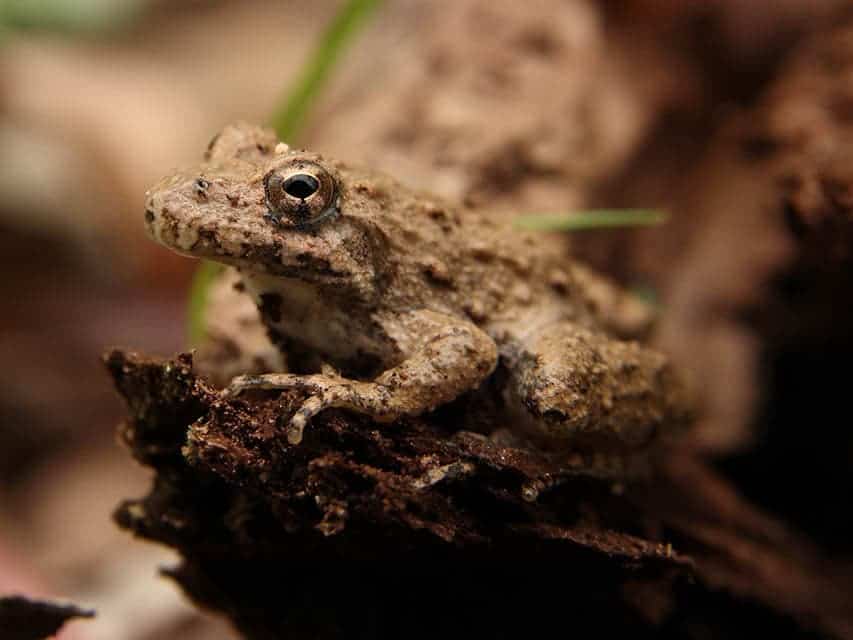
| Species: | Acris blachardi |
| Longevity: | 1 year |
| Good to own as a pet?: | Yes |
| Legal to own?: | Yes |
| Adult size: | 1.5 inches |
| Diet: | Insects |
Despite their small size, these tiny frogs can jump extremely high—up to 6 feet in many cases. Their coloration ranges a bit from orange or black to green. They are mainly found in northern Kentucky, where they prefer slow-moving streams, lakes, and ponds. They may also be found in marshy areas.
Their breeding call sounds like the chirp of a cricket and is usually repeated for about 20 beats.
10. Northern Cricket Frog
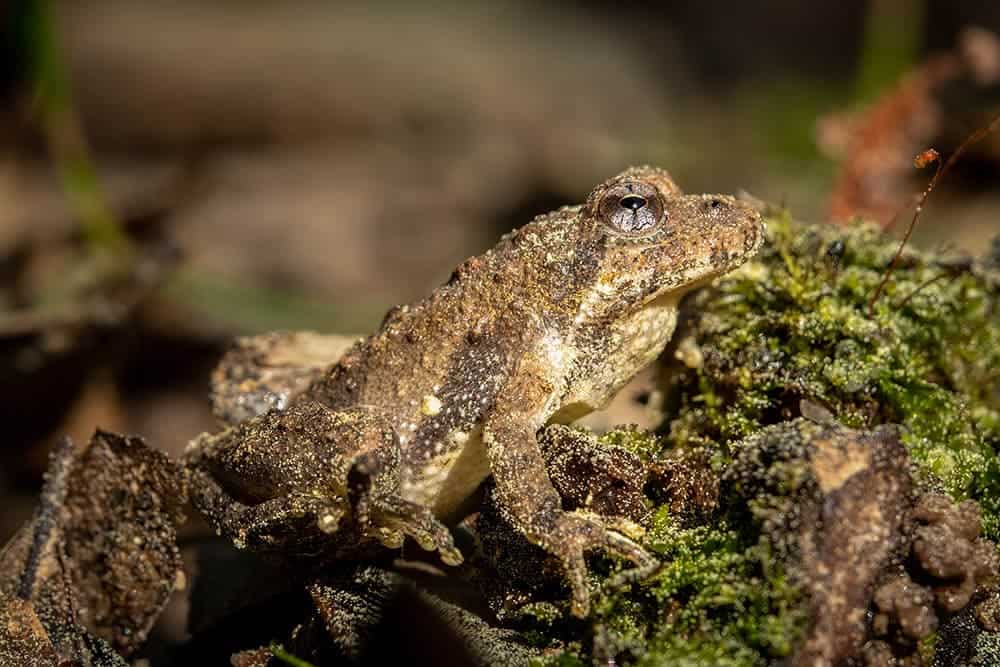
| Species: | Acris crepitans |
| Longevity: | 4 months |
| Good to own as a pet?: | Yes |
| Legal to own?: | Yes |
| Adult size: | 1.5 inches |
| Diet: | Insects |
As its name suggests, this frog sounds a lot like a cricket. Its coloration ranges from green to brown. Some frogs are even a grayish color. It usually has a backward triangle on its head, which is an easy way to identify it.
These frogs are found near permanent water sources, like slow-moving streams, lakes, and marshy areas. They are found south and west of the Kentucky River drainage area.
11. Upland Chorus Frog

| Species: | Pseudacris feriarum |
| Longevity: | 5 years |
| Good to own as a pet?: | Yes |
| Legal to own?: | Yes |
| Adult size: | ¾ to 1 ½ inches |
| Diet: | Anything that fits in their mouth |
These tiny frogs have three dark stripes that run down the backs of their heads. They are usually brown, grey-brown, or reddish. Dark blotching is common. This is a rare species to see due to its secretive nature. It usually prefers to stay hidden, though it may be spotted after it rains.
It’s also rare in Kentucky, so the odds of just stumbling on one are unlikely.
12. Bird-Voiced Tree Frog
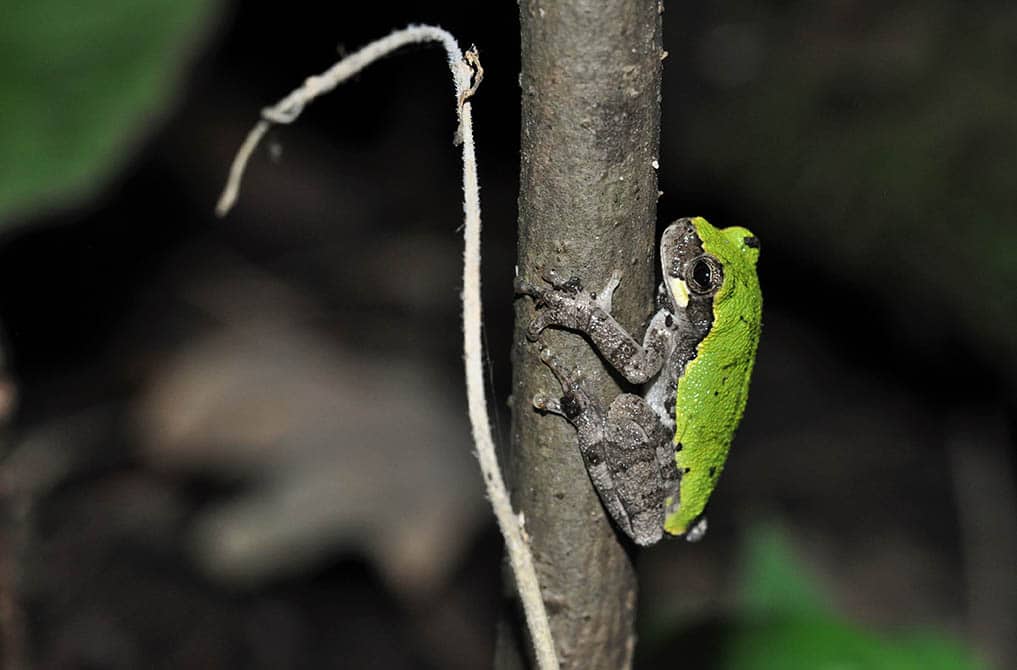
| Species: | Hyla avivoca |
| Longevity: | 2.5 years |
| Good to own as a pet?: | Yes |
| Legal to own?: | Yes |
| Adult size: | 1 to 1 ¾ inches |
| Diet: | Insects and spiders |
The coloration of this frog varies widely. It can be either gray or green, depending on the individual. Often, it has a light spot under its eyes. These frogs look very similar to Cope’s gray tree frogs, though they do sound quite different.
They have been known to interbreed with other tree frogs naturally, which has resulted in some interesting hybrids.
The 7 Big Frogs in Kentucky
13. American Bullfrog
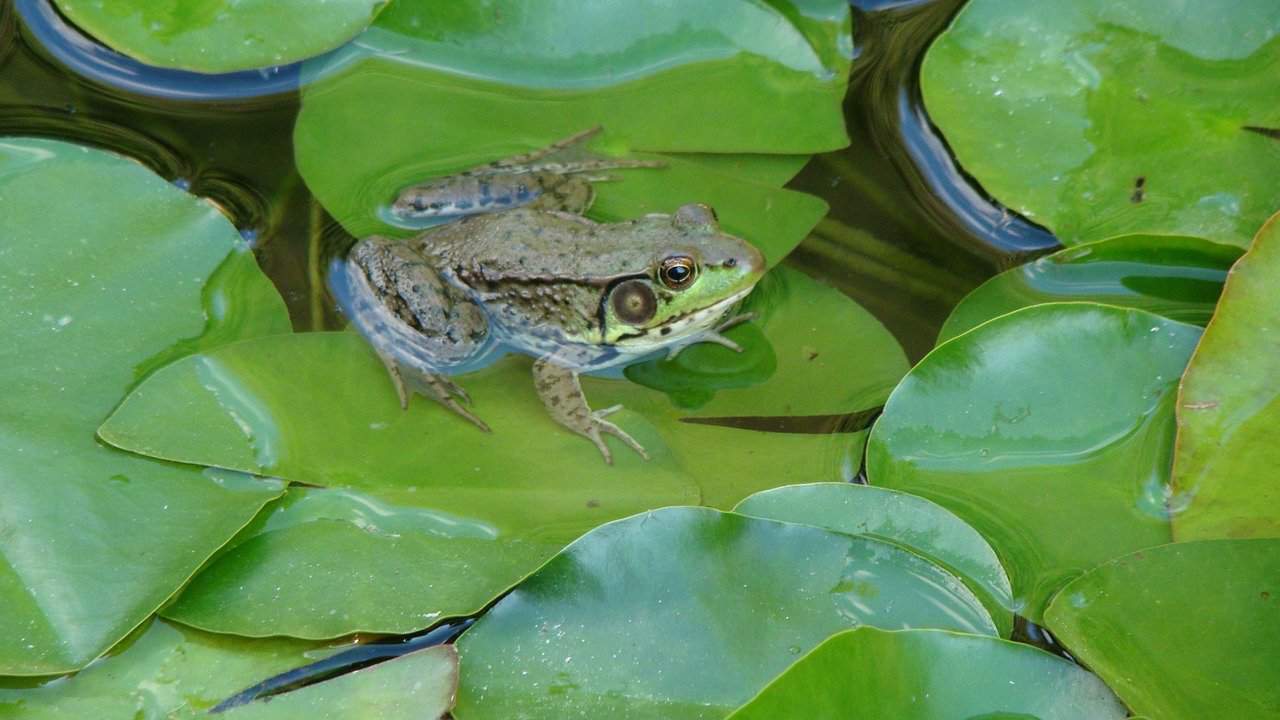
| Species: | Lithobates catesbeianus |
| Longevity: | 7–9 years |
| Good to own as a pet?: | Yes |
| Legal to own?: | Yes |
| Adult size: | 8 inches |
| Diet: | Anything that fits in their mouth |
Like most Bullfrogs, this species grows to be rather large. It can weigh up to a pound and a half when it reaches its full size. These frogs are often found near bodies of water with plenty of dense vegetation around the shoreline.
They are common throughout Kentucky and can be found in every county.
14. Green Frog
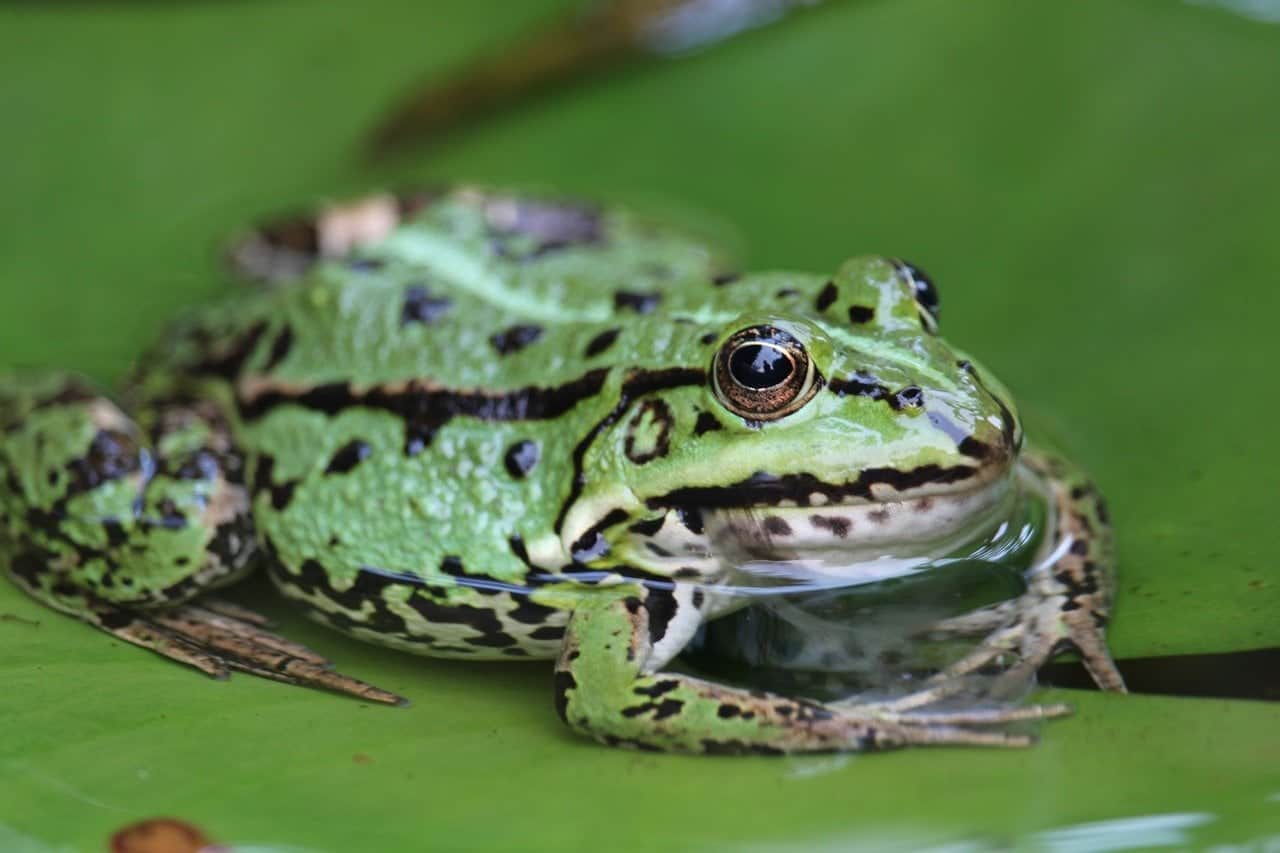
| Species: | Lithobates clamitans |
| Longevity: | Unknown |
| Good to own as a pet?: | Yes |
| Legal to own?: | Yes |
| Adult size: | 2 ½–3 ½ inches |
| Diet: | Anything that fits in their mouth |
Based on their name, you would expect these frogs to be very green. However, they range from dark green to brownish. They have dark molting across much of their heads, chests, and legs. Their throat color ranges from yellow for males to white for females.
They are abundant in Kentucky and can adapt to many different habitats. They prefer the water, though.
15. Green Tree Frog
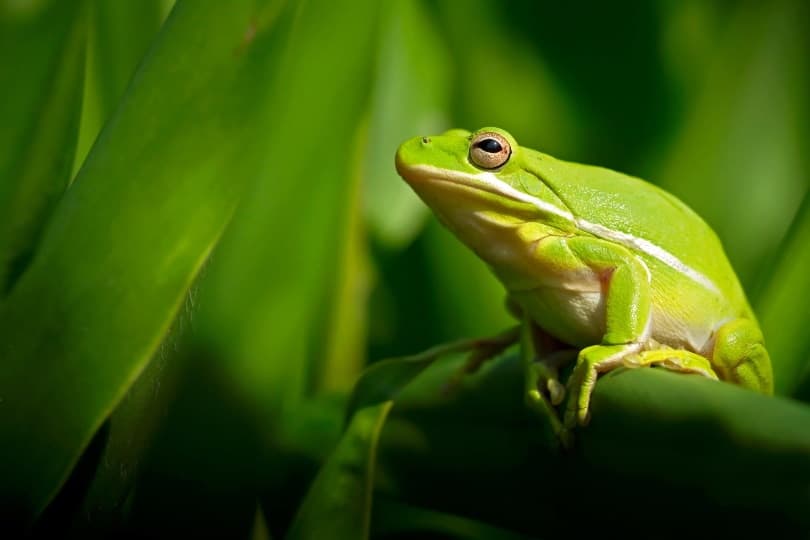
| Species: | Hyla cinerea |
| Longevity: | 6 years |
| Good to own as a pet?: | Yes |
| Legal to own?: | Yes |
| Adult size: | 2.5 inches |
| Diet: | Insects |
As their name suggests, the Green Tree Frog comes in various shades of green. It usually has a white stripe down its side, enabling you to identify it quickly.
Despite their somewhat larger size, these frogs are easily frightened. Usually, they can be found in marshes, swamps, ponds, and streams. Currently, they are only in the western tip of Kentucky.
16. Crawfish Frog
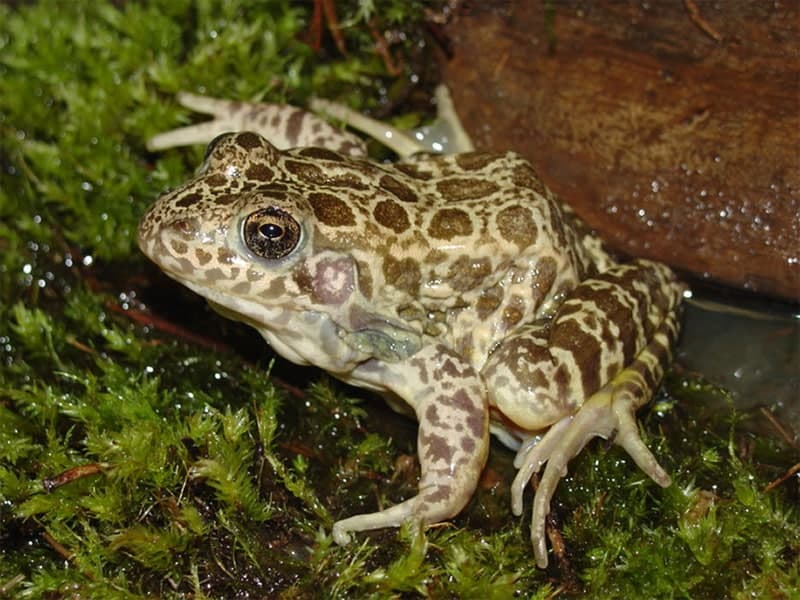
| Species: | Lithobates areolatus |
| Longevity: | Unknown |
| Good to own as a pet?: | Yes |
| Legal to own?: | Yes |
| Adult size: | 2–3 inches |
| Diet: | Beetles, reptiles, crawfish, and amphibians |
The Crawfish Frog has a large, stubby body and extremely humped back when standing still. It has many different irregular stripes and spots across its body, making it look unique compared to other frogs.
These frogs can be found in a variety of habitats, including prairies and meadows. They don’t require water, but many can also be found around permanent lakes and ponds. They are only found in the westernmost counties of Kentucky.
17. Barking Tree Frog
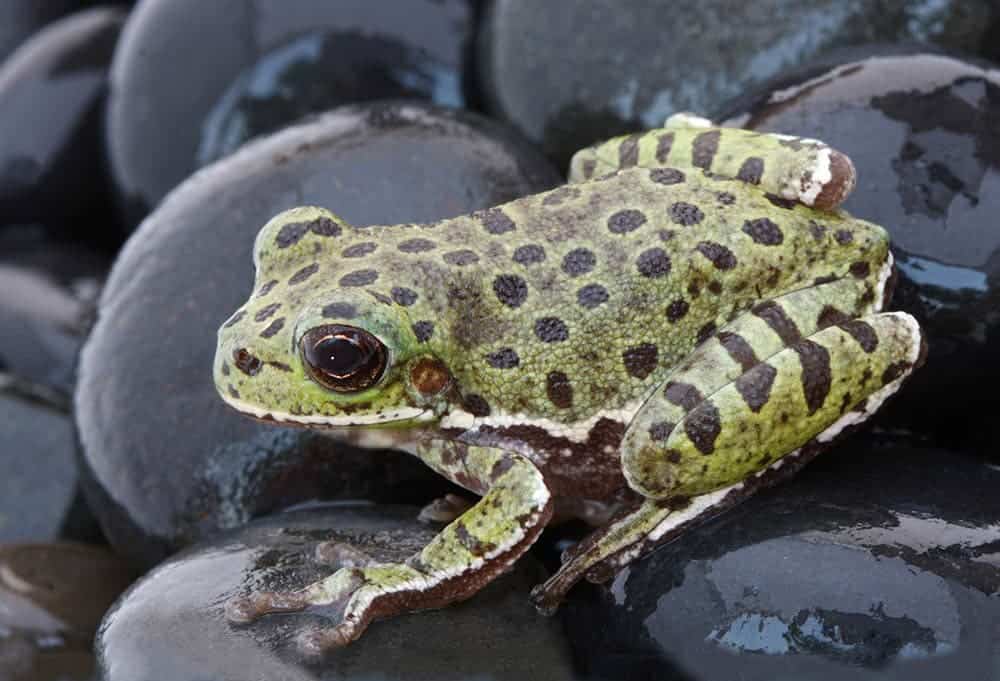
| Species: | Hyla gratiosa |
| Longevity: | 8–10 years |
| Good to own as a pet?: | Yes |
| Legal to own?: | Yes |
| Adult size: | 3 inches |
| Diet: | Insects |
The Barking Tree Frog is unique. First, it prefers areas that don’t have any trees or permanent standing water. This gives it very few options in Kentucky. How this frog can thrive without trees or standing water is a mystery.
It can be seen burrowing into the sand when the weather gets overly hot. Some may also climb the rare trees in the area.
18. Plains Leopard Frog
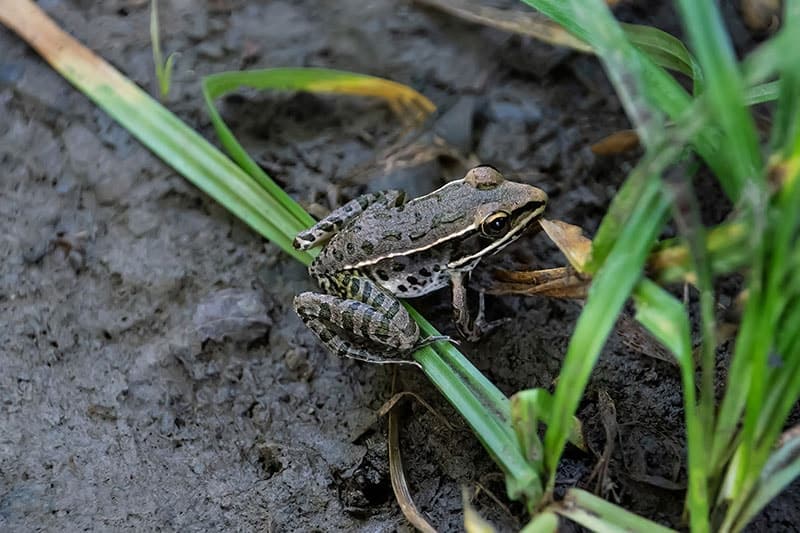
| Species: | Lithobates blairi |
| Longevity: | 2–4 years |
| Good to own as a pet?: | Yes |
| Legal to own?: | Yes |
| Adult size: | 3 3/4 inches |
| Diet: | Insects, some vegetation |
This species is a medium brown with dark spots across its body. Its eardrum is very obvious, making it easier to identify it. These aren’t giant frogs, but they can get bigger than 3 inches.
They prefer streams, ponds, ditches, and similar habitats. In mild weather, they can travel quite far from water. This is one of the rarest frogs in Kentucky, so the odds of seeing it are pretty low.
19. Southern Leopard Frog

| Species: | Lithobates sphenocephala |
| Longevity: | 6–9 years |
| Good to own as a pet?: | Yes |
| Legal to own?: | Yes |
| Adult size: | 4 inches |
| Diet: | Anything that fits in their mouth |
The Southern Leopard Frog gets its name from its uneven, oval-shaped dots. Kentucky is home to three different leopard frogs, but this is the most common species. It can be found in a variety of different habitats, depending on its needs. For instance, it will forage in fields and meadows while overwintering in permanent bodies of water.
It will consume just about anything that fits in its mouth and is a very opportunistic eater.
Related Reads:

Conclusion
There are quite a few frogs that can be found in Kentucky. Some of them are unique, while other species can be hard to distinguish.
Luckily, none of these species are hazardous. One is poisonous, which may be troublesome for those looking to eat it. However, that usually doesn’t include humans, so most of us don’t have anything to worry about. The poison is far more about making the frog taste bad, not necessarily killing the predator. Therefore, large dogs probably aren’t in any danger either.
Learning to identify frogs involves looking at their appearance and listening to their call. With some of the Kentucky tree frogs, the only way to tell them apart is to listen to their call. It can vary just as much as their appearance.
Featured Image Credit: Bernell MacDonald, Pixabay
